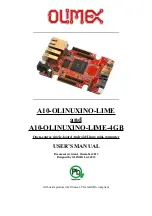
also may be driven by other microprocessors or DMA controllers that reside
on the I/O channel.
M16# (I)
M16# Chip Select signals the system board if the present data transfer is a
1 wait-state, 16-bit, memory cycle. It must be derived from the decode of
LA[23::17]. M16# should be driven with an open collector or tri-state driver
capable of sinking 20 mAmps.
Master16# (I)
Master16# is used with a DRQ line to gain control of the system. A processor
or DMA controller on the I/O channel may issue a DRQ to a DMA channel in
cascade mode and receive a DAK#. Upon receiving the DAK#, an I/O
microprocessor may pull Master16# low, which will allow it to control the system
address, data, and control lines (a condition known as tri-state). After
Master16# is low, the I/O microprocessor must wait one system clock period
before driving the address and data lines, and two clock periods before issuing
a Read or Write command. If this signal is held low for more than
15 microseconds, system memory may be lost because of a lack of refresh.
NOWS# (I)
The No Wait State (NOWS#) signal tells the microprocessor that it can
complete the present bus cycle without inserting any additional wait cycles. In
order to run a memory cycle to a 16-bit device without wait cycles, NOWS# is
derived from an address decode gated with a Read or Write command. In
order to run a memory cycle to an 8-bit device with a minimum of two wait
states, NOWS# should be driven active on system clock after the Read or Write
command is active gated with the address decode for the device. Memory
Read and Write commands to a 8-bit device are active on the falling edge of
the system clock. NOWS# is active low and should be driven with an open
collector or tri-state driver capable of sinking 20 mAmps.
OSC (O)
Oscillator (OSC) is a high-speed clock with a 70-nanosecond period (14.31818
MHz). This signal is not synchronous with the system clock. It has a 50% duty
cycle.
REFRESH# (I/O)
The REFRESH# signal is used to indicate a refresh cycle and can be driven
by a microprocessor on the I/O channel.
RESDRV (O)
Reset Drive (RESDRV) is used to reset or initialize system logic at power-up
time or during a low line-voltage outage. This signal is active high.
SA[19::0] (I/O)
Address bits SA[19::0] are used to address memory and I/O devices within the
system. These twenty address lines, in addition to LA[23::17], allow access
ISA REFERENCE
2-6
TECHNICAL REFERENCE
Содержание SB586TCP/166
Страница 2: ...This page intentionally left blank...
Страница 11: ...SPECIFICATIONS TECHNICAL REFERENCE 1 3...
Страница 44: ...This page intentionally left blank PCI REFERENCE 2 20 TECHNICAL REFERENCE...
Страница 94: ...This page intentionally left blank ADVANCED SETUP 5 18 TECHNICAL REFERENCE...
Страница 106: ...This page intentionally left blank PERIPHERAL SETUP 7 8 TECHNICAL REFERENCE...
Страница 122: ...This page intentionally left blank BIOS MESSAGES A 16 TECHNICAL REFERENCE...
Страница 128: ...This page intentionally left blank TECHNICAL REFERENCE...


































